The story of this strange lake has attracted the attention of many people, causing experts and the media to investigate.
Ho Dun in Xincheng County, Guangxi Province, China, caused a stir when he suddenly disappeared and then reappeared in a mysterious way.
The Sudden Disappearance of the Mysterious Lake
According to a 2021 article published by The Paper, in Longchun Village, Suiyi Township, Xincheng County, Guangxi Province, there is a beautiful lake surrounded by mountains, which is called "Dun Lake" by the locals (in the local language, "Dun" means a depression between the mountain peaks submerged in water). In early March 2007, the water in Dun Lake suddenly dried up. Strangely, in mid-June of the same year, after a heavy rain, the water in the lake rose again.
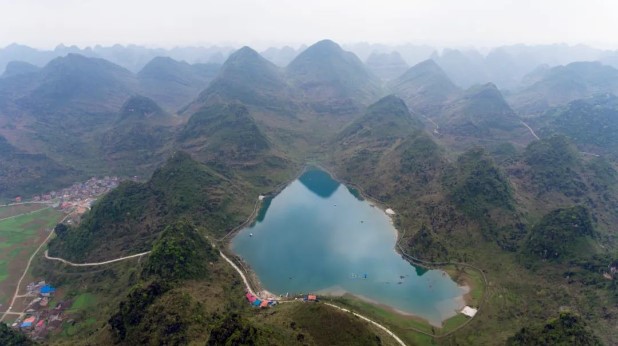
Aerial view of a lake in Long Xuan village, Toai Y commune, Han Thanh district, Guangxi province, China. (Photo: Sohu)
To find out the truth about this mysterious Dun Lake, reporters from China Central Television (CCTV) went there three times to record and report on programs such as News, World Discovery, Science Discovery... attracting the attention of many experts and scholars across the country.
According to CCTV, late at night on March 9, 2007, a strange incident occurred in Long Xuan village. The sleeping villagers suddenly heard a rumbling sound coming from the direction of Dun Lake - a lake located in the middle of the valley behind the village. Then there was a strange continuous buzzing sound. In the middle and southwest corner of Dun Lake, giant whirlpools appeared, sucking water down. The water level of the lake began to gradually decrease.
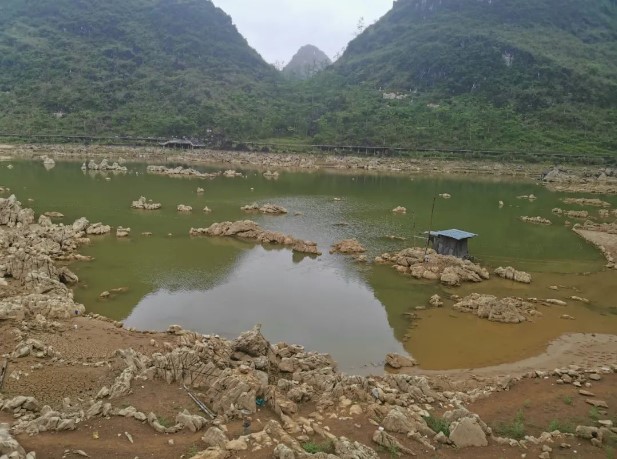
After the noise on the night of March 2007, the water in the lake gradually receded. (Photo: Sohu)
The next morning, the villagers ran to the lake and saw that the water had receded by more than a meter. In the middle of the lake and the southwest shore, giant whirlpools like "hungry mouths" were swallowing water into the ground. The strange buzzing sound was coming from these "mouths". The lake's water level dropped by two to three meters every day. By the afternoon of the 14th, about 85% of the water had disappeared, and the lake bottom was exposed. The lake was about to dry up!
In the memory of the people, Don Lake was not a lake but a cultivated valley. Perhaps because there was an underground river flowing through it, every time there was heavy rain in May and June, water from many underground streams in the valley would overflow, submerging the land and crops. Fish from the underground river also rose up with the water to compete for young rice and weeds. When the rain stopped, the flood water in the valley quickly receded, leaving only a few fish and shrimp that did not have time to "retreat" to jump around in the fields, becoming delicious dishes on the dining tables of the local people.
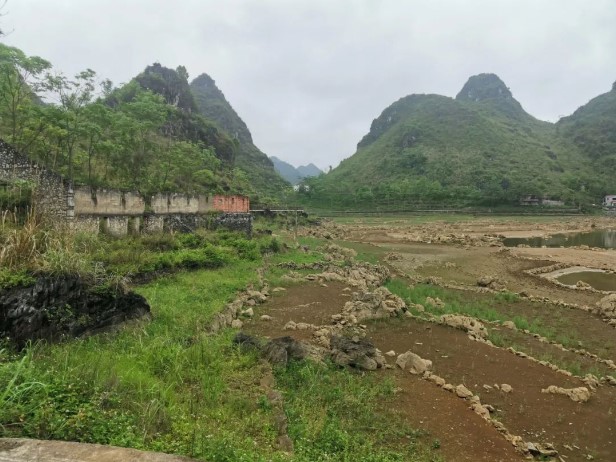
In people's memories, Dun Lake was not a lake but a cultivated valley. (Photo: Sohu)
However, in the summer of 1999, an unusually heavy rain occurred. The underground river water in the valley rose more than 20 meters and did not recede, creating a majestic scene of high mountains and flat lakes. The continuous flow of underground water made the valley green and lush, with abundant fish and shrimp, and a stable water surface area of over 400 acres, becoming a real "mountain lake".
After the initial shock, the local people lost part of their farmland, but they adapted by building rafts, weaving nets, farming and fishing every day. However, when the people were getting used to life in the land of fish and shrimp, nature teased them by taking away the water of Don Lake.
Expert explanation: Dun Lake is a Karst lake
What caused Dun Lake to suddenly dry up? Expert Chu Dehao (Karst Geomorphology Research Institute, Chinese Academy of Geological Sciences) said that Dun Lake is a Karst lake. Karst lakes, also known as "karst lakes", are widely distributed in limestone areas. Karst lakes are a type of erosion lake, which can be formed by corrosive water dissolving limestone to form a water-filled depression, or by groundwater dissolving salt in the soil causing subsidence to form a subsidence lake.
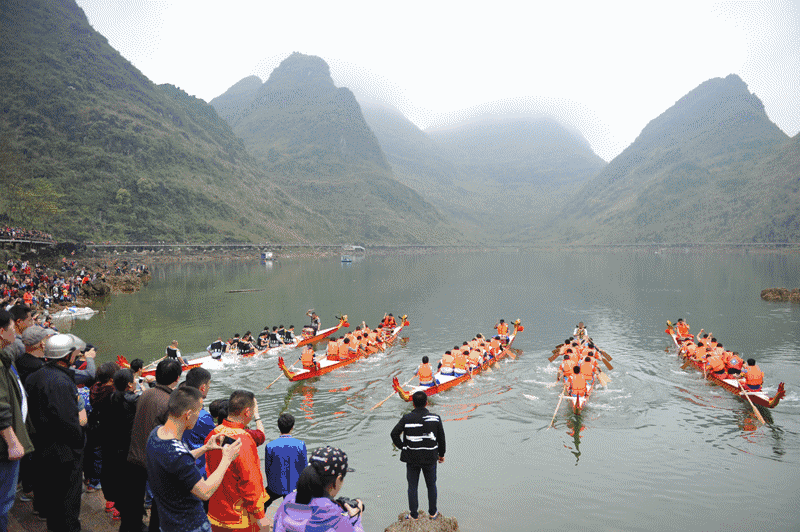
Expert Chu Duc Hao said this lake is a Karst lake. (Photo: Sohu)
Expert Chu Dehao added that Karst lakes in China are mainly concentrated in Guizhou, Guangxi and Yunnan provinces, where Karst terrain develops, mainly due to faults and subsidence of the geological strata. "The rainfall in the South is quite large, and surface water often flows through water holes. But when the water holes are blocked by tree branches, rocks, and mud and sand flowing down from upstream, the water cannot drain away and accumulates into lakes."
Ho Don recreates its ancient appearance
"Ho Dun has water again!" . Three months after it suddenly dried up, Ho Dun suddenly reappeared. The change in Ho Dun in 2007 made the locals feel like it was a myth. Long Xuan village chief Lam Thuong Dat said the water started to rise on May 24.
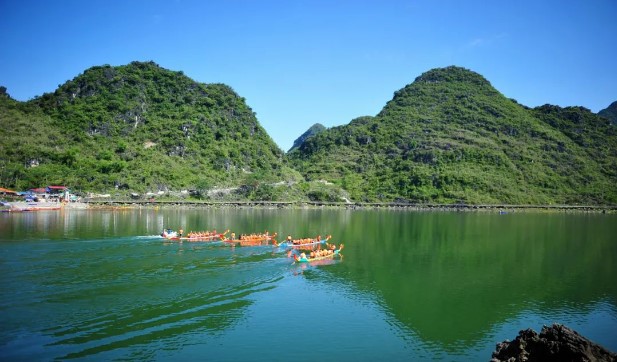
Three months after suddenly drying up, Lake Dun suddenly reappeared. (Photo: Sohu)
The night before the 24th, there was heavy rain in this area. Early the next morning, some people brought fishing gear to the lake. Mr. Lam Thuong Dat recalled that the scene at that time was extremely majestic. Hundreds of caves were spraying water loudly. The large caves were more than two meters in diameter, the small caves were thirty to forty centimeters. The water sprayed out was clear and cool. Many people even went to the edge of the cave to play in the water.
More than 10 days later, the lake water gradually rose. On June 15, when he returned to the lake, he saw that the water surface area had expanded to about 200 acres, equivalent to more than half of what it was before it dried up. Mr. Lam Thuong Dat added that in the following days, they often went to the lake to measure and saw that the water level was still rising at a rate of about 10 centimeters per day. On February 7, 2009, when CCTV reporters went to Long Xuan village for the third time, the water level of Dun Lake had risen to nearly three-quarters of what it was before it dried up.
Nguyet Pham (Synthesis)
Source: https://giadinh.suckhoedoisong.vn/sau-tieng-dong-lon-trong-dem-ho-nuoc-nam-tren-hang-tram-mau-dat-bien-mat-mot-cach-day-bi-an-172241206071425882.htm



![[Photo] T&T 1 and Ho Chi Minh City 1 People's Police Teams won the men's and women's team championships](https://vphoto.vietnam.vn/thumb/1200x675/vietnam/resource/IMAGE/2025/5/22/39db06ae67cb4001b7a556e8d9a56d07)
![[Photo] Prime Minister Pham Minh Chinh chairs meeting on draft Resolution of National Assembly on International Financial Center in Vietnam](https://vphoto.vietnam.vn/thumb/1200x675/vietnam/resource/IMAGE/2025/5/22/d398664ff1a140629169ea5a24e1b4d0)
![[Photo] Press delegation meeting to visit Truong Sa and DK1 Platform](https://vphoto.vietnam.vn/thumb/1200x675/vietnam/resource/IMAGE/2025/5/22/6b8d232877ec421a9e8187d83b9f8006)
![[Photo] General Secretary To Lam chairs a working session with the Central Internal Affairs Commission](https://vphoto.vietnam.vn/thumb/1200x675/vietnam/resource/IMAGE/2025/5/22/3b7790f499da45b2803d8ae253207ef1)





































































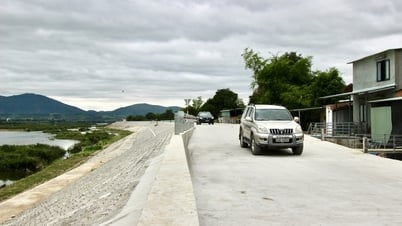







![[Podcast] Week introducing more than 500 OCOP products in Hanoi](https://vphoto.vietnam.vn/thumb/402x226/vietnam/resource/IMAGE/2025/5/22/d144aac2416744718388dbae3260e7fd)





Comment (0)